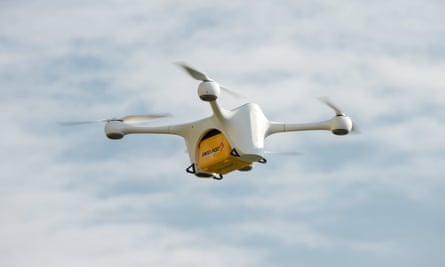A hi-tech start-up aiming to bust congestion and reduce pollution with wheeled delivery robots is facing a backlash from the very city it is aiming to help.
Order a delivery meal from a local restaurant in San Francisco’s Mission and Potrero Hills neighbourhoods using Yelp Eat24 and it might arrive at your door in a suitcase-sized wheeled robot.
The tech company Marble’s bots use lidar, camera and ultrasonic sensors to avoid pedestrians and navigate pavements, delivering small packages and takeaway food within a mile or two, at walking pace.
But if one San Francisco official has his way, every pizza the Marble robot delivers could come with a $1,000 fine and a jail sentence for its human controllers.
San Francisco supervisor Norman Yee recently proposed legislation that would prohibit autonomous delivery robots – which includes those with a remote human operator – on public streets in the city. He told technology news site Recode, “our streets and our sidewalks are made for people, not robots.” He also worries that many delivery jobs would disappear.
San Francisco police commander Robert O’Sullivan is in favour of the legislation, fearing the robots could harm children, the elderly, and those with limited mobility. “If hit by a car, they also have the potential of becoming a deadly projectile,” he told a local TV station.
Marble CEO Matt Delaney says these fears are unfounded. “We care that our robots are good citizens of the sidewalk,” he says. “We’ve taken a lot of care from the ground up to consider their need to sense and intuit how people are going to react.”
Similar robots from Starship Technologies, an Estonian company started by Ahti Heinla and Janus Friis, two of the founders of Skype, are already delivering food in Germany, the Netherlands, the UK – and just down the road from San Francisco in Silicon Valley.
“We can get this technology out sooner than self-driving cars because it’s not going to hurt anybody,” says Brad Templeton, a robotics expert working with Starship. “You can’t kill a pizza. You can ruin it but that’s not a disaster.” The company says that its robots have covered tens of thousands of pavement miles in cities around the world, and have met millions of people, with zero accidents to date.
Their argument is that robots can in fact help with the urban problems of traffic jams, air pollution and road accidents.
There is no doubt that a growing appetite for online shopping and food delivery is choking cities. In London, travel times are increasing by 12% a year, even as people get on their bikes in record numbers. Delivery vans are more than making up the difference, and now account for nearly a fifth of all traffic in the capital. Val Shawcross, London’s deputy mayor for transport, has even proposed banning the city’s workers from ordering goods direct to work.
In the US, researchers at the Oak Ridge National Laboratory calculated that delays from double-parked delivery vans alone cost the country over $10bn a year. And although Amazon and Google have been working on delivery drones, concerns remain over their safety, range, and carrying capacity, as well as their sheer buzzing annoyance.

Robots like those from Starship and Marble are capable of carrying about 80% of all goods ordered online, says Henry Harris-Borland of Starship, as well as takeaway meals. Many jurisdictions are embracing them – with provisos. Virginia and Idaho have already passed laws permitting the robots, limiting their weight, and their speed to 10mph. Washington DC’s law, passed last year, permits delivery robots everywhere except the city’s crowded central business district.
Harris-Burland says the process of passing laws has generally been painless: “If you’re a city councillor and you’ve got a device coming in to reduce congestion by taking vans off the roads, reduce pollution, increase convenience, and reduce cost while assisting the elderly and disabled by delivering groceries to their door, it ticks a lot of boxes.”
Of course, it is the “reduce cost” box that appeals to restaurants. Starship believes that it will eventually be able to offer local delivery for around $1 (78p) but admits that it is some way from that price. That is because today’s robots still need humans, earning at least the minimum wage, to remotely control them at tricky points, such as crossings and traffic lights.
Even if the robots become smart enough to negotiate potholes, puddles, and pets, they are years away from being able to climb stairs or open doors. There is also the social cost of robots replacing tens of thousands of delivery workers to consider. “But having someone jump into a car is not only not great for environment, there are only so many people willing to work for those wages and in those conditions,” says Matt Delaney.
If the proposed San Francisco legislation does become law, Marble should be able to find somewhere friendlier to develop its robots fairly easily. Ultimately, says Brad Templeton, nothing will stop the inevitable rise of the delivery robots: “A patchwork of rules is OK when you’re starting out. I’d rather have competition between 50 states trying to write the best rules for a year or two before settling down. In the long run, we’ll want one rule but let’s let towns experiment.”
Sign up to be a Guardian Sustainable Business member and get more stories like this direct to your inbox every week. You can also follow us on Twitter.

Comments (…)
Sign in or create your Guardian account to join the discussion